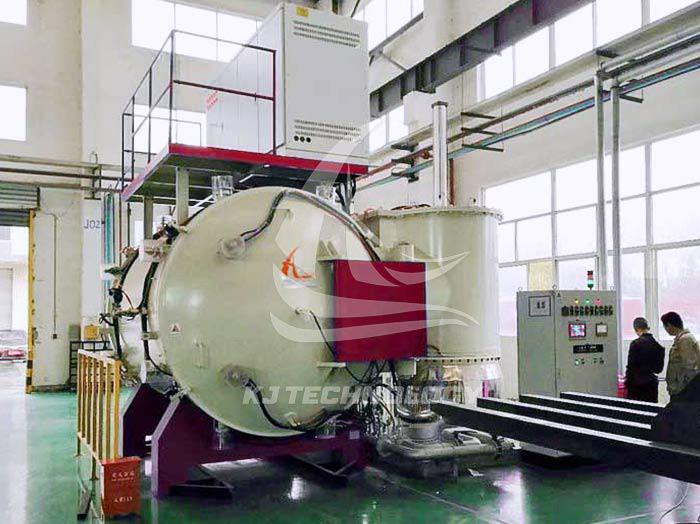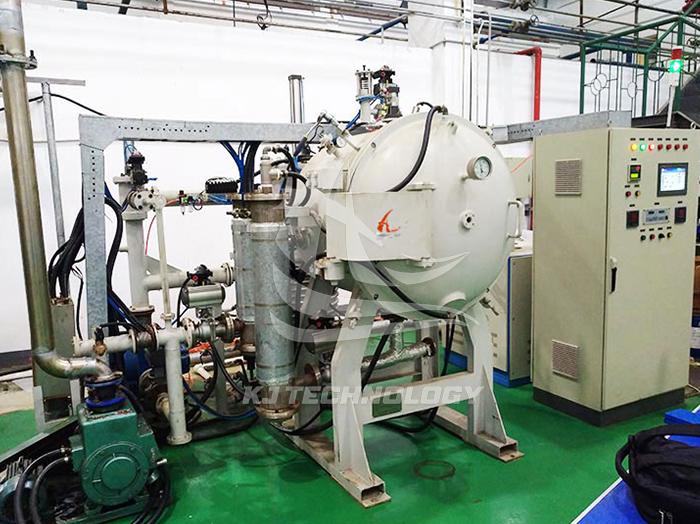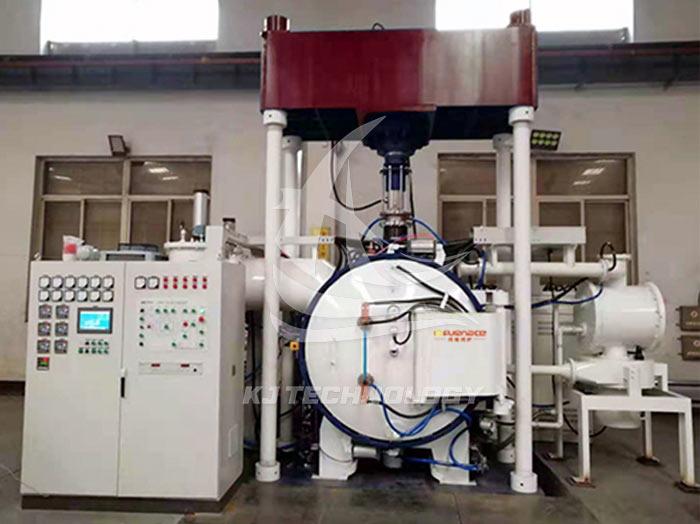Precautions for using electric heating vacuum heat treatment furnace
 08-14-2025 Author: KJ technology
08-14-2025 Author: KJ technology
As a high-precision heat treatment equipment, the electric heating vacuum heat treatment furnace must strictly follow the operating specifications to ensure equipment performance, process quality, and personnel safety. The following are key precautions during use, covering four aspects: preparation before operation, operation monitoring, safety protection, and maintenance:
1. Preparation before operation: Ensure equipment and process compatibility
Equipment inspection and calibration
Vacuum system: Check the oil level of the vacuum pump (at 1/2-2/3 of the oil window), oil quality (without emulsification or impurities), test the accuracy of the vacuum gauge (error ≤± 5%), and ensure that the vacuum degree meets the process requirements (such as 10 ⁻ Pa level).
Heating system: Verify the resistance value of the heating element (deviation from the rated value ≤ 10%), check the position of the thermocouple (distance from the workpiece ≤ 5mm) and the connection of the compensation wire to avoid temperature measurement distortion.
Gas system: Confirm gas purity (such as high-purity argon gas ≥ 99.999%), pressure stability (fluctuation ≤± 0.01MPa), and check the sealing of pneumatic valves (leakage rate ≤ 10 ⁻⁹ Pa · m ³/s).
Workpiece pre-processing
Cleanliness: Remove oil stains, rust, and oxide scales from the surface of the workpiece (such as using ultrasonic cleaning+alcohol wiping), avoiding contamination of the furnace or affecting the vacuum degree.
Furnace loading method: Select specialized fixtures based on the shape of the workpiece (such as shafts or plates) to ensure uniform heating; Control the furnace loading (usually ≤ 80% of the effective volume of the furnace) to avoid uneven temperature caused by airflow obstruction.
Process parameter setting
Temperature curve: Set the heating rate (generally ≤ 10 ℃/min), holding time (e.g. quenching holding time=effective thickness of workpiece × 1.5min/mm), and cooling method (oil cooling, air cooling, or furnace cooling) based on material characteristics (such as Ac1 and Ac3 points of steel).
Vacuum degree control: Select the vacuum stage according to the process requirements (such as rough pumping to 10Pa → fine pumping to 10 ⁻ Pa), to avoid material oxidation in the low temperature range (such as titanium alloy needs to maintain a vacuum degree of ≤ 10 ⁻ ² Pa above 400 ℃).
2. Operation monitoring: Real time guarantee of process stability
Vacuum monitoring
Observe the changes in vacuum gauge readings. If the pumping time is abnormally prolonged (such as exceeding 30% of the rated time), check for leaks in the vacuum pump, valve, or furnace body (helium mass spectrometer leak detector can be used to locate the leak point).
Maintain a stable vacuum degree in the high temperature range (such as ≥ 800 ℃) to avoid contamination of the furnace by material volatiles (such as zinc in aluminum alloy, which is prone to volatilization at high temperatures, and the vacuum degree should be controlled to ≤ 10 ⁻¹ Pa).
Temperature uniformity control
Monitor temperature distribution through multi-point thermocouples (usually ≥ 3) inside the furnace. If the temperature difference exceeds the allowable range of the process (such as ± 5 ℃), adjust the heating power or optimize the furnace loading method.
Avoid local overheating (such as the workpiece being too close to the heating element) and prevent material performance degradation (such as coarsening of steel grains leading to a decrease in hardness).
Cooling process management
Air cooling: Control the inflation rate (such as ≤ 0.5MPa/min) to avoid cracking of the workpiece due to thermal stress; Monitor the temperature of the cooling gas (such as argon inlet temperature ≤ 50 ℃) to ensure cooling efficiency.
Oil cooling: Check the quenching oil temperature (usually 40-60 ℃) and fluidity to avoid soft spots or deformation of the workpiece (such as using graded quenching for thin-walled parts).
3. Security protection: Avoiding operational risks
Personnel protection
Operators need to wear protective equipment (such as heat-resistant gloves, goggles, gas masks) to avoid contact with high-temperature components (such as furnace doors, heating elements) or inhaling harmful gases (such as quenching oil volatiles).
During the operation of the vacuum pump or the cooling stage of the furnace body, it is forbidden to open the furnace door to prevent high-pressure gas or hot oil splashing.
Equipment safety
Overpressure protection: Set a safety valve with a popping pressure (usually 1.1 times the working pressure) to prevent furnace overpressure explosion.
Electrical safety: Regularly check the grounding resistance (≤ 4 Ω) and insulation resistance (≥ 1M Ω) to prevent leakage or short circuit; Avoid operating equipment in humid environments (relative humidity>75%).
Emergency stop: Familiarize yourself with the location of the emergency stop button, and immediately cut off the power and exhaust when the equipment is abnormal (such as a sudden drop in vacuum or temperature loss).
environmental safety
Ensure that there are no flammable materials (such as oil stains and paper scraps) around the equipment, and equip fire extinguishing equipment (such as carbon dioxide fire extinguishers); The quenching oil tank needs to be equipped with an oil mist collection device to reduce volatile emissions.
Exhaust gas treatment: Purification treatment (such as catalytic combustion or activated carbon adsorption) is carried out on the exhaust gas (such as CO, NOx) generated by quenching, tempering and other processes, and it is discharged after meeting the standards.
4. Maintenance: Extend the service life of equipment
Routine maintenance
Furnace cleaning: After each use, remove residues such as oxide scale and slag (such as dry ice cleaning or mechanical brushing) to avoid contaminating subsequent workpieces.
Vacuum pump maintenance: Regularly replace the vacuum pump oil (every 500 hours or according to the degree of oil deterioration), clean the oil filter (every 1000 hours), and ensure good heat dissipation of the pump body (oil temperature ≤ 70 ℃).
Seal inspection: Check the sealing rings (such as fluororubber O-rings) of furnace doors, observation windows, and other parts every month. If aging or cracks are found, replace them in a timely manner to avoid vacuum leakage.
Regular maintenance
Heating element: Check the resistance value of the heating element every six months, and replace it if the deviation is greater than 15%; Check if the connecting wires are loose or oxidized to ensure good contact.
Thermocouple: Calibrate the accuracy of the thermocouple annually (using a standard temperature source for comparison), and replace it if the error is greater than ± 2 ℃; Check if the protective sleeve is damaged to prevent short circuits.
Gas system: Clean the gas filter quarterly (such as using ultrasonic cleaning+nitrogen blowing), check the valve sealing (such as using soap water for leak detection), and ensure smooth gas flow.
Long term suspension management
If the equipment is not in use for more than one month, the gas inside the furnace should be emptied (filled with dry nitrogen for protection), and all valves should be closed; Power off the heating element and hang a warning sign to avoid accidental operation.
Regularly (every 2 weeks) start the vacuum pump and run it for 10 minutes to prevent corrosion of the pump body; Perform low-temperature baking (100 ℃, 2 hours) on the furnace every quarter to remove moisture.








